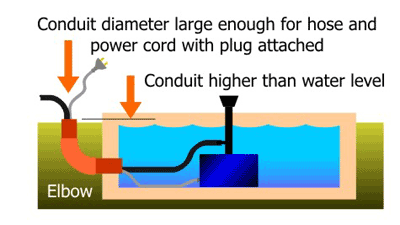How do I get the Cable or Pond Hose connected to my submersible Pond Pump out of my pond or trough without any leaks and without any ugly cables or hoses showing?
A common question we get here at Creative Pumps. Fortunately there are a few options available to get you out of trouble.
When installing a submersible pond pump in a pond, it is essential that you are able to remove the pump to service it. No matter which pump you buy, eventually it will need to be repaired or replaced. Cutting the plug off because the cable has been concreted into the pond will instantly void your warranty and also make sure it is impossible to repair your pond pump. There are easy solutions to the problem which will save you a lot of time and hassle in the future.
1. a) FOR CABLE - Use an Oase Tradux or Pondmax Cable Gland Outlet. This is a special fitting designed for walls of ponds or troughs which are not too thick (works great for pre-formed plastic ponds and troughs). You cut a hole below the water level and install the fitting in the side and it allows you to take it apart when you need to remove the pump for servicing. Also ideal for pond lighting. No visible cables running over the edge of your pond.


1. b) FOR PIPEWORK - Use one of our Barbed Transition Kits or Threaded Transition Kits to take your pipework through wall as thin as a plastic trough right up to thicknesses of 300mm such as double brick or large concrete or stone blocks. They are designed for flat surfaces and can be purchased with hose barbs or threaded fittings. They come with rubber washers to create a waterproof seal and are easy to install.
2. FOR CABLE AND PIPEWORK - Build a larger conduit, such as 50mm PVC pipe (big enough to fit your plug and pond hose through), with a bend, into the wall of your pond. ensure that the bottom of the conduit enters the pond below the water level and that the top of the conduit ends above the water level.
This way you can simply pass the pond hose that feeds your water feature up through the conduit. You can also pass the plug for your pond pump through the conduit and on to your power source. The conduit will always be partially filled with water which is why it is essential the conduit outlet is above the water level.
This method works well for concrete ponds and water feature troughs. See the below diagram for an example.

